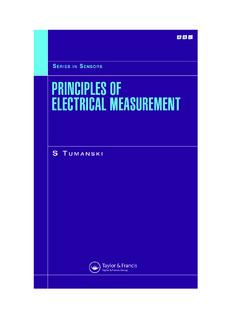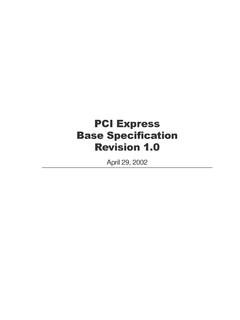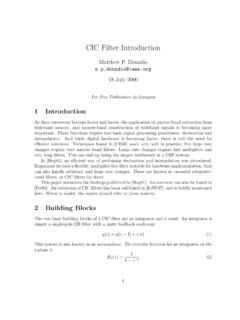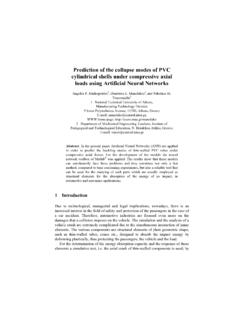Transcription of Fuzzy Logic Rules for Turbomachine Monitoring …
1 Fuzzy Logic Rules FOR Turbomachine Monitoring INSTRUMENTATION C. Anagnostopoulos (1), I. Anagnostopoulos (1), E. Kayafas (1) and V. Loumos (1) (1) national technical university of Athens, Department of Electrical and Computer Engineering, 9 Heroon Polytechneiou Str., Zographou, Athens, GR - 157 73, Greece. Phone: +30 1 772 2544, Fax: +30 1 772 2538, e-mail: Abstract - Turbomachines maintenance diagnostic procedures are generally performed manually by expert engineers and technicians. However, there is a strong interest for expert systems to assist them in these complex fault identification procedures. The purpose of this paper is to describe and evaluate the implementation of a Fuzzy Logic (FL) system for fault diagnosis based on thermodynamic measurements of temperature and pressure.
2 The measurements were taken in regular aerodynamic stations located lengthwise the engine. These stations are placed adequately in order to facilitate its performance Monitoring . Keywords - Fuzzy C- Means, Neural Networks, Diagnostic system, Thermodynamic measurements. 1. INTRODUCTION The current research aims to identify the advantages of Fuzzy Logic Rules technology in turbine engine fault diagnosis. The CFM56 3 engine is a dual spoon turbofan designed and manufactured by CFM International. The engine incorporates a single-stage fan (A) and three-stage ( ) low-pressure compressor (B) driven by a four-stage ( ) low-pressure turbine (F).
3 A nine-stage axial flow ( ) high-pressure compressor (C) is driven by a single-stage ( ) high-pressure turbine (E). The inlets and outlets of the above engine components (2,25,3,4,45,5) are the most suitable stations for placing Monitoring instruments on a jet engine like the CFM56-3 [1]. These stations are indicated in Figure 1. Figure 1. The thermodynamic stations of the CFM 56-3 jet engine. 2. NATURE OF THE PROBLEM Within automatic control of technical systems, supervisory functions serve to indicate undesired or unpermitted process states and to take appropriate actions in order to maintain the operation and to avoid damages or accidents [2].
4 The following aspect are met in the Fuzzy system proposed in this paper, which was built on Matlab by Mathworks Inc: a) Monitoring using Fuzzy Rules : measurable variables are checked with regard to specific tables and accepted tolerances. b) Fault diagnosis: based on measured variables, features are calculated, a fault diagnosis is performed and decisions are made for counteractions. Due to the fact that Fuzzy set theory has the potential capability to efficiently represent input/output relationships of dynamic systems, this theory has gained popularity, especially in pattern recognition and classification [3],[4],[5],[6].
5 An increasing activity can be observed in the field of Fuzzy control systems and neural networks, for fault diagnosis in rotating machinery and jet engines. In some cases the combination of Fuzzy Logic and neural networks integrates the advantages of both approaches in one controller [7],[8],[9]. Controllers can be designed in the Fuzzy sense using heuristic knowledge. On the other hand, they can be trained from learning data by means of algorithms developed for neural networks. In any case, there is structural equivalence between certain types of Fuzzy systems and artificial neural networks [10],[11].
6 This paper aims also to perform a comparison between the Fuzzy Logic System and the Neural Network classifier trained on the same dataset [12]. The basic concept in FL, which plays a central role in most of its applications, is that of a Fuzzy if-then rule or, simply, the Fuzzy rule. In the proposed system measurements taken during the take-off operation point of the engine s cycle and then clustered using a specific membership grade. These membership functions (MF) formed the basis for the definition of the Fuzzy Logic Rules . These if-then rule statements are used to formulate the conditional statements that comprise the Fuzzy Logic -based Turbomachine Monitoring system.
7 The purpose of this paper is to describe the implementation of Fuzzy Logic (FL) system and evaluate its performance with real life thermodynamic measurements during various operating points of the machine. The input of the system is the measurement set consisting of thermodynamic patterns such as temperature and pressure. Additionally the structural elements of the system are discussed analytically. 3. METHODS OF RESEARCH Clustering of numerical data forms the basis of many classification and system modeling algorithms. The purpose of clustering is to identify natural groupings of data from a large data set to produce a concise representation of a system s behavior.
8 Fuzzy c-means (FCM) is a data clustering technique wherein each data point belongs to a cluster to some degree that is specified by a membership grade. This technique was originally introduced by Jim Bezdek in [13] as an improvement on earlier clustering methods. It provides a method of how to group data points that populate some multidimensional space into a specific number of different clusters. An initial guess for the cluster centers is calculated randomly, which is intended to mark the mean location of each cluster. The initial guess for these cluster centers is most likely incorrect. Additionally, a membership grade for each cluster is assigned in every data point.
9 By continuously updating the cluster centers and the membership grades for each data point, the cluster centers are moved to the right location within a data set. This iteration is based on minimizing an objective function that represents the distance from any given data point to a cluster center weighted by that data grade. Table 1. Engine s parameters corresponding to its conditions The system was originally built on the basis of the Fuzzy Logic Toolbox of MATLAB by Mathworks Inc. The whole system was based on the initial training of the system in order to create successfully membership functions to represent the Fuzzy qualities of each cluster.
10 After this training it can be assumed that the membership functions represent successfully the statistical nature of the if-then Rules of the problem. 4. EXPERIMENTAL RESULTS The Fuzzy C- Mean method has clustered thermodynamic patterns namely temperature ( C) and pressure (bar)- measured in aerodynamic stations, during the take-off operation point of the engine s cycle [14]. The training set was created with values corresponding to healthy instances, along with cases of engine malfunction. The malfunction cases represent insignificant, moderate or severe faults in the compressor, combustion chamber and turbine part of the engine [14], as shown in Table 1.









